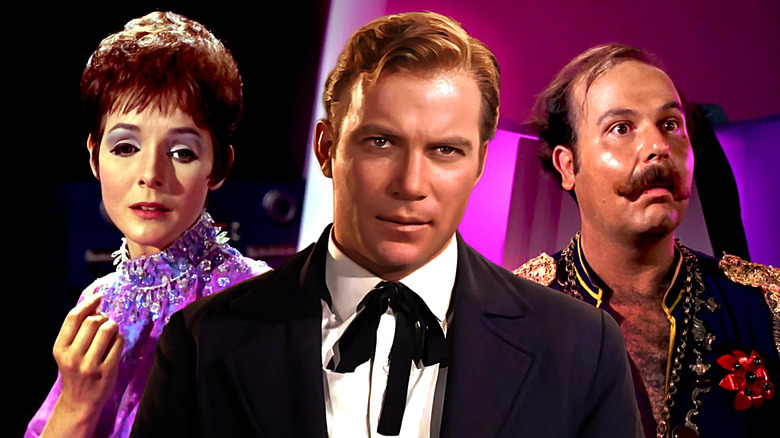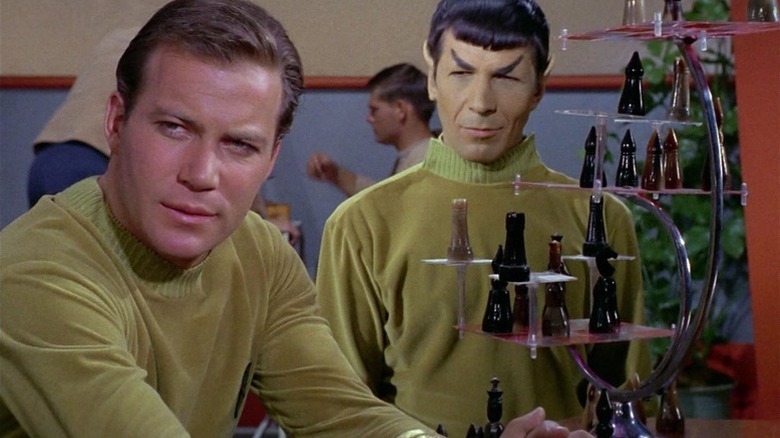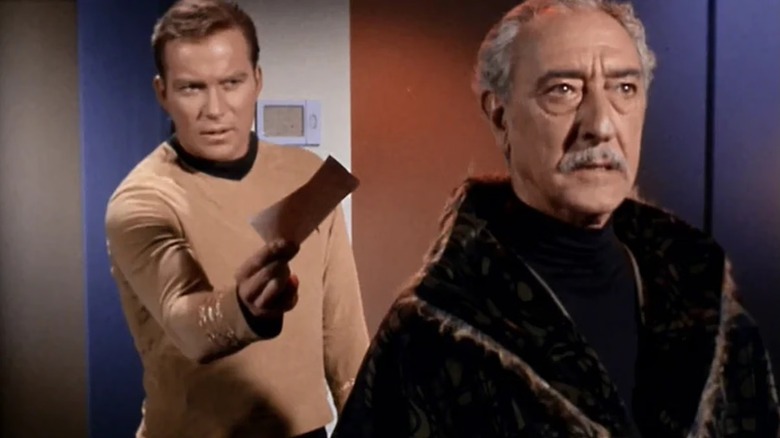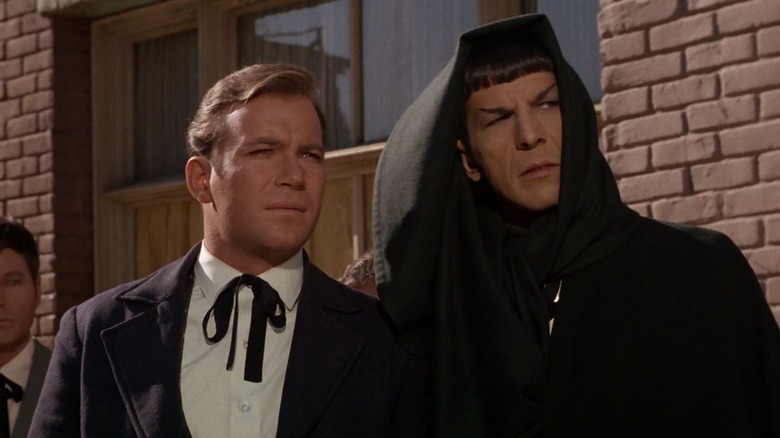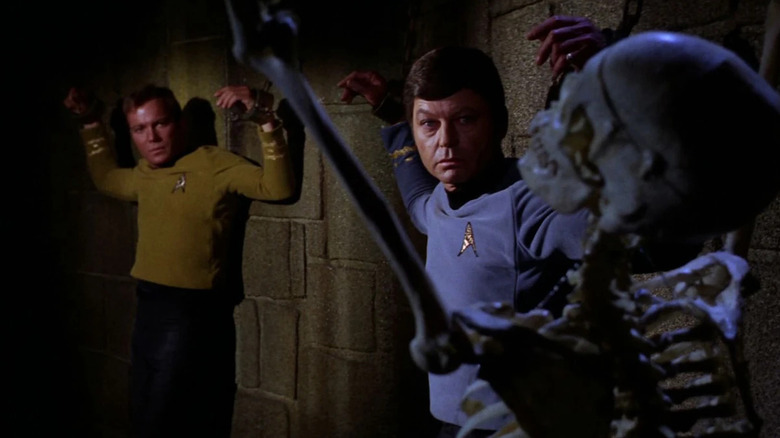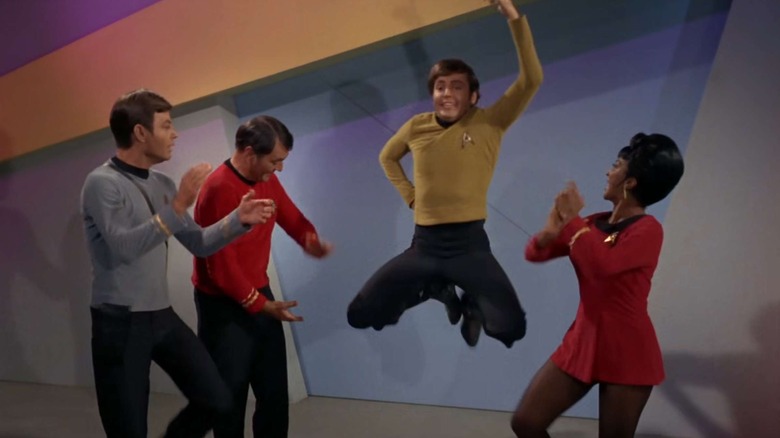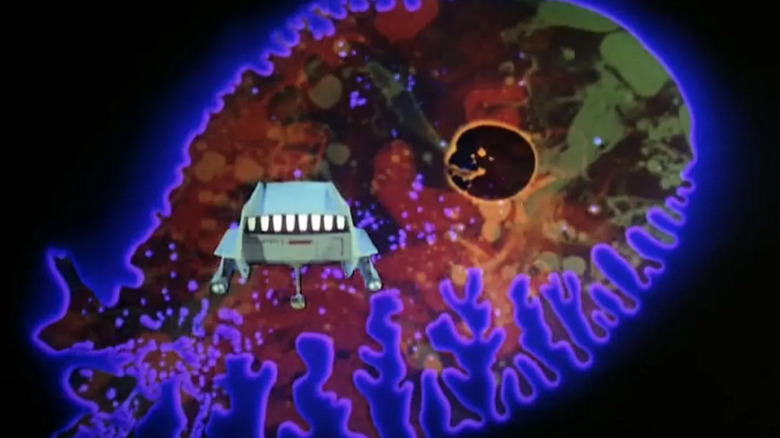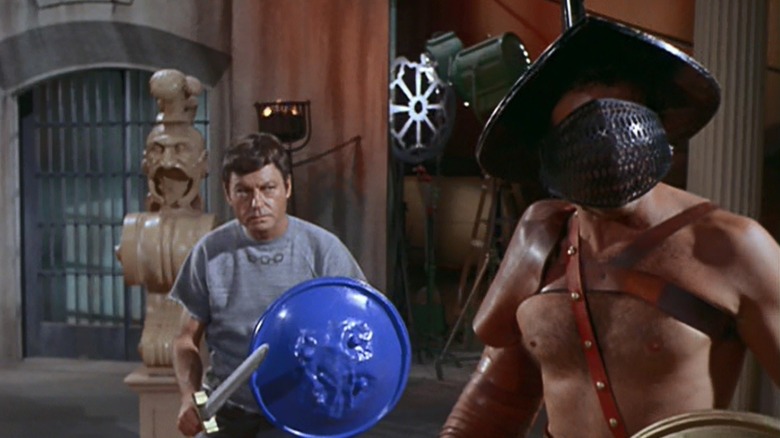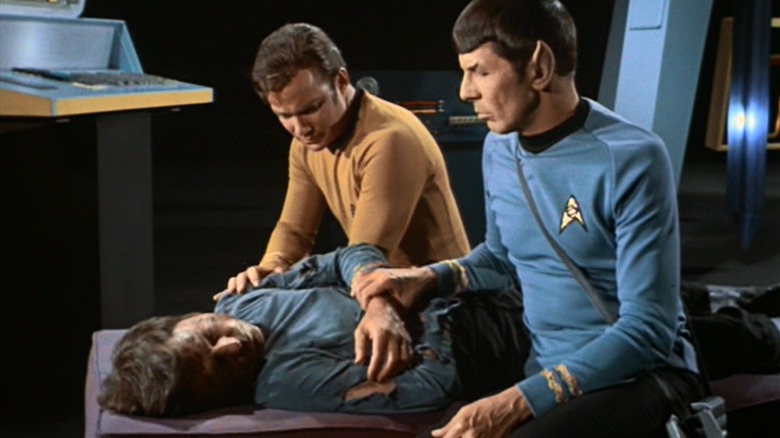10 Most Underrated Star Trek: The Original Series Episodes
Even decades after its end, "Star Trek: The Original Series" remains one of the most influential science fiction shows around, even after only running for three seasons. While the series produced celebrated stories like "The City on the Edge of Forever," there are plenty of "TOS" episodes that truly hit the mark, but go largely overlooked. Whether not quite the level of critical darlings as their more acclaimed counterparts or featuring offbeat narrative premises, there are "TOS" episodes that deserve more love. Indeed, some episodes not included on the more prominent best-of lists are hidden gems that may have eluded more casual "Star Trek" fans for years.
From the most overtly comedic episode to murder mysteries on the iconic starship Enterprise, "TOS" wasn't afraid to mix up its usual storytelling formula. And even the more unorthodox episodes in the series have since earned their fair share of vocal fans. These include several prominent filmmakers and television producers today, with at least one of whom having gone on to help steer the future of "Star Trek." Without further ado, here are the 10 most underrated "Star Trek: The Original Series" episodes.
Where No Man Has Gone Before
"Star Trek" actually produced two pilots before officially being greenlit for a series order, with the latter, "Where No Man Has Gone Before," airing as part of its first season. The episode has the Enterprise try to venture beyond the borders of the galaxy, only to be hit by a cosmic energy barrier. The incident gives two crew members, including Captain Kirk's (William Shatner) old friend Gary Mitchell (Gary Lockwood), godlike powers that warp their minds. As Mitchell grows more dangerous while his powers develop, Kirk has to make the impossible choice to prevent the situation from escalating.
One of the things that gets "Where No Man Has Gone Before" dismissed is that the show clearly hasn't found its defining aesthetics yet. The uniforms and interior layout of the Enterprise are markedly different than subsequent episodes, while there are inconsistencies with Spock's (Leonard Nimoy) depiction, and even Kirk's middle name. Still, despite the lack of the familiar faces and elements audiences have come to identify "TOS" with, this is a solid episode overall. It's easy to see why "Where No Man Has Gone Before" got the series to air and it still stands as a great, more action-packed story.
The Conscience of the King
The first season episode "The Conscience of the King" is a strange one for a number of reasons, starting with the Enterprise transporting a troupe of Shakespearean actors. Kirk secretly suspects the troupe's leader of being Kodos (Arnold Moss), the governor of a colony he lived in years ago that was responsible for the massacre of thousands. More concerning is that only a handful of eyewitnesses to Kodos' crimes are left alive, as they've been steadily picked off wherever this acting troupe conveniently visits. As Kirk works to prove that his guest is Kodos, he becomes targeted as the mysterious killer's next target.
Kirk trying to figure out if a guest on his starship is a figure responsible for his traumatic past is an interesting setup for a "Star Trek" episode. It also gives Shatner deeper and more nuanced material to play Kirk than he gets in many "TOS" episodes, which he takes advantage of. Future "Star Trek" writer and producer Ronald D. Moore cited the episode among his favorites from "TOS." Given the enduring legacy that Moore himself left with the franchise, it's easy to see why a more emotionally complex episode like this would appeal to him.
The Return of the Archons
A common practice in "TOS," in a budget-saving move, would have the Enterprise visit planets with societies mirror historical periods from Earth, right down to the wardrobe and architecture. The first episode "The Return of the Archons" has Kirk and his landing party investigate a culture similar to the United States in the 19th century. This society is ruled by Landru (Charles Macaulay), who is revealed to be a sentient supercomputer repressing the emotions of citizens through advanced mind control. As Kirk's crew is forcibly assimilated into Landru's collective and the Enterprise is targeted for destruction, Kirk and Spock move to dismantle Landru's control.
Filmmaker and actor Ben Stiller is a self-professed "Star Trek" fan and named his production company Red Hour Films as a direct reference to "The Return of the Archons." The episode establishes a common narrative for the series, with Kirk working to overthrow a regime that sacrifices free will in the name of peace. This episode is less bombastic than "The Apple" or high-concept as "A Taste of Armageddon," which follow a similar formula, but it's still effective here. A fun showcase for the undercover partnership of Kirk and Spock, "The Return of the Archons" is a solid first season episode.
Catspaw
Whenever a "Star Trek" series leans into the horrific possibilities of the sci-fi unknown, it usually yields memorable results. The first episode produced for the second season of "TOS" was "Catspaw," which originally aired in time for Halloween 1967. After a mysterious accident strands a landing party, Kirk leads a follow-up investigation himself after a dead crewman from the party ominously warns him that the Enterprise is cursed. The search party encounters everything from witches to a haunted castle as they recover the rest of the initial team and barely escape with their lives.
As influential as "TOS" is, the series is undeniably campy at times, a quality that helps give the show its distinct sense of charm. With its concept of the Enterprise visiting a haunted planet, including being stalked by a gigantic black cat, "Catspaw" is definitely one of the series' campier episodes. But what this installment also brings is plenty of Halloween appropriate atmosphere, from its omnipresent fog to skeleton-filled dungeons. If you're doing a watch of the horror-oriented "Star Trek" episodes, "Catspaw" absolutely needs to make that playlist.
I, Mudd
Just as "Star Trek" has been known to occasionally veer into horror, the franchise also is no stranger to comedy, effectively leaning into the humorous potential of its premise. The most overtly comedic story in "TOS" is the second season episode "I, Mudd," with the Enterprise reuniting with interstellar con artist Harry Mudd (Roger C. Carmel). Androids hijack the Enterprise and take it to a remote planet where they intend to imprison and study the crew along with their fellow prisoner, Mudd. Realizing that the androids are strictly governed by logic, the crew begin exhibiting bizarre, over-the-top behavior to confuse and overwhelm their captors' programming.
As far as humorous "TOS" episodes go, "I, Mudd" tends to be overshadowed by "The Trouble with Tribbles" and "A Piece of the Action." Though easily the silliest of the three, "I, Mudd" is an enjoyable romp within the second season, especially compared to its more self-serious counterparts. The main cast clearly appears to be having a blast with their goofy performances, and the episode is the best appearance of Harry Mudd in the franchise to date. Funny and knowingly bizarre in its premise and execution, "I, Mudd" is a strong reminder that "Star Trek" doesn't always need to be so self-important.
Wolf in the Fold
Just as the second season of "TOS" featured a Halloween episode, it also had a proto-slasher story, with both episodes written by "Psycho" novelist Robert Bloch. While enjoying some much-needed recreation at a pleasure planet, Montgomery Scott (James Doohan) is implicated in the murder of a local dancer, found holding a bloody knife near the victim. As Scotty is investigated, the body count of women around him steadily grows, along with the mounting evidence that he's snapped and become a serial killer. However, it becomes clear that a malevolent entity is involved in the string of killings, one that has menaced humanity for centuries.
The Enterprise versus Jack the Ripper premise that drives "Wolf in the Fold" is another campy concept, but one that is surprisingly entertaining in its execution. There are elements of the episode that haven't aged well, particularly Spock's reasoning why Jack the Ripper primarily targets women, but "TOS" has always been a product of its time. Plus, the idea of a slasher story involving the "TOS" era Enterprise is too enticing for any horror fan to pass up. The most terrifying episode from "TOS," "Wolf in the Fold" is a bloody cut above most in the series.
The Immunity Syndrome
From vampiric clouds to doomsday machines, the Enterprise confronts many dangerous elements prowling the unexplored corners of the galaxy. The second season episode "The Immunity Syndrome" certainly features one of the more visually striking spacebound threats in the series in the form of a gigantic amoeba. Consuming everything in its path, the Enterprise is inextricably drawn into its protoplasmic body and steadily loses energy as it advances towards the creature's nucleus. Running out of options, Spock volunteers to take a shuttle deeper into the organism and study it for vulnerabilities before the Enterprise runs out of power and is completely consumed.
There are episodes in "TOS" that handle the Enterprise facing a cosmic anomaly better than "The Immunity Syndrome," but this installment is still a solid story in its own right. Kirk debating which crew member to send away to seemingly certain death beautifully captures the dynamic between him, Spock, and Leonard McCoy (DeForest Kelley). And the sequences within the amoeba, particularly when the nucleus appears on the horizon, are some of the most psychedelic visuals in "TOS." An effective bottle episode in the series, "The Immunity Syndrome" doesn't necessarily bring anything new to the table, but is a fantastic distillation of what the show is all about.
Bread and Circuses
The second season episode "Bread and Circuses" features a historical mish-mash of time periods when the Enterprise visits a planet with 20th century technology but maintaining Roman-inspired societal trappings. Tracing the cross-cultural contamination to a missing Starfleet survey vessel, Kirk leads the landing party to investigate further. Captured by the planet's ruling class, Kirk and his friends are sentenced to the civilization's televised gladiatorial games. This leads to them becoming involved in a revolutionary religious movement against the planet's aristocracy as the landing party looks for a way to escape back to the Enterprise.
Seeing Kirk, Spock, and McCoy run around in a facsimile of Ancient Roman society is entertaining enough, but "Bread and Circuses" has a subtle subversive quality to it. Seeing gladiatorial producers complain about ratings and resort to canned applause and boos to illicit reactions is a sly commentary on television itself. This is underscored by the 20th century elements of this seemingly primitive planet, itself a hodge-podge of styles and influences. The penultimate episode aired during season 2, "Bread and Circuses" is the last strong gasp before "TOS" enters shakier ground for its final season.
Spectre of the Gun
Going into its third season, "TOS" had its episodic production budget slashed considerably to bring it back on the air. That meant the creative team had to get particularly inventive to work around the financial limitations they endured to continue the show. The episode "Spectre of the Gun" encapsulates this, with Kirk and his senior officers transported to relive the gunfight at the O.K. Corral as the ill-fated Clanton Gang. Reflecting the series' low budget at the time, the Wild West setting is visibly incomplete, with only abstract elements of its frontier town intact.
Despite the economic realities facing the show at the time, "Spectre of the Gun" uses these limitations to elevate it above a really routine premise. There is an otherworldly quality to the episode fueled by its incomplete setting and reinvention of Western tropes as only "Star Trek" can. Actor Walter Koenig, who memorably played Pavel Chekhov throughout the franchise, cited the episode as one of his personal favorites because of economic-mandated creativity. A highlight in an all-around weaker season, "Spectre of the Gun" shows how much the series could do with less.
The Empath
Another third season episode visibly affected by the series' slashed production budget but still works effectively in spite of it is "The Empath." While visiting a research facility on a remote planet, Kirk and the landing party find it deserted and its personnel tortured to death by a subterranean race known as Vians. As Kirk and McCoy become the Vians' latest torture victims, they learn its part of an experiment to draw out the empathic powers of a woman named Gem (Kathryn Hays). In addition to surviving the Vians' grueling experiments, the landing party must find a way to return to the Enterprise before the planet is consumed by an impending supernova.
Reflecting the budget, much of the episode takes place in a darkened soundstage, with only minimal set dressings visible. That spartan presentation works well for the episode, stripping down the usually gaudy trappings for something grimmer and more foreboding reflected by its practically black box theater look. Interestingly, because of the episode's prominent torture sequences, "The Empath" went unaired in general British broadcasts for almost 30 years. A great stripped-down "Star Trek" episode that proves bigger and colorful surroundings aren't necessary for solid stories, "The Empath" is another late series standout.
